Spazio: ultima frontiera. Credere che si sia soli nell'universo è come credere che la Terra sia piatta. Come disse l'astrofisico Labeque al palazzo dell'UNESCO, durante il congresso mondiale del SETI di Parigi del Settembre 2008, " SOMETHING IS HERE", "Qualcosa è qui", e I TEMPI SONO MATURI per farsene una ragione. La CIA, l'FBI, la NSA, il Pentagono, e non solo, lo hanno confermato!
Statistiche
Friday, July 30, 2021
New Swarming Capability Planned For The V-Bat Vertical Takeoff And Landing Drone ( The war Zone )
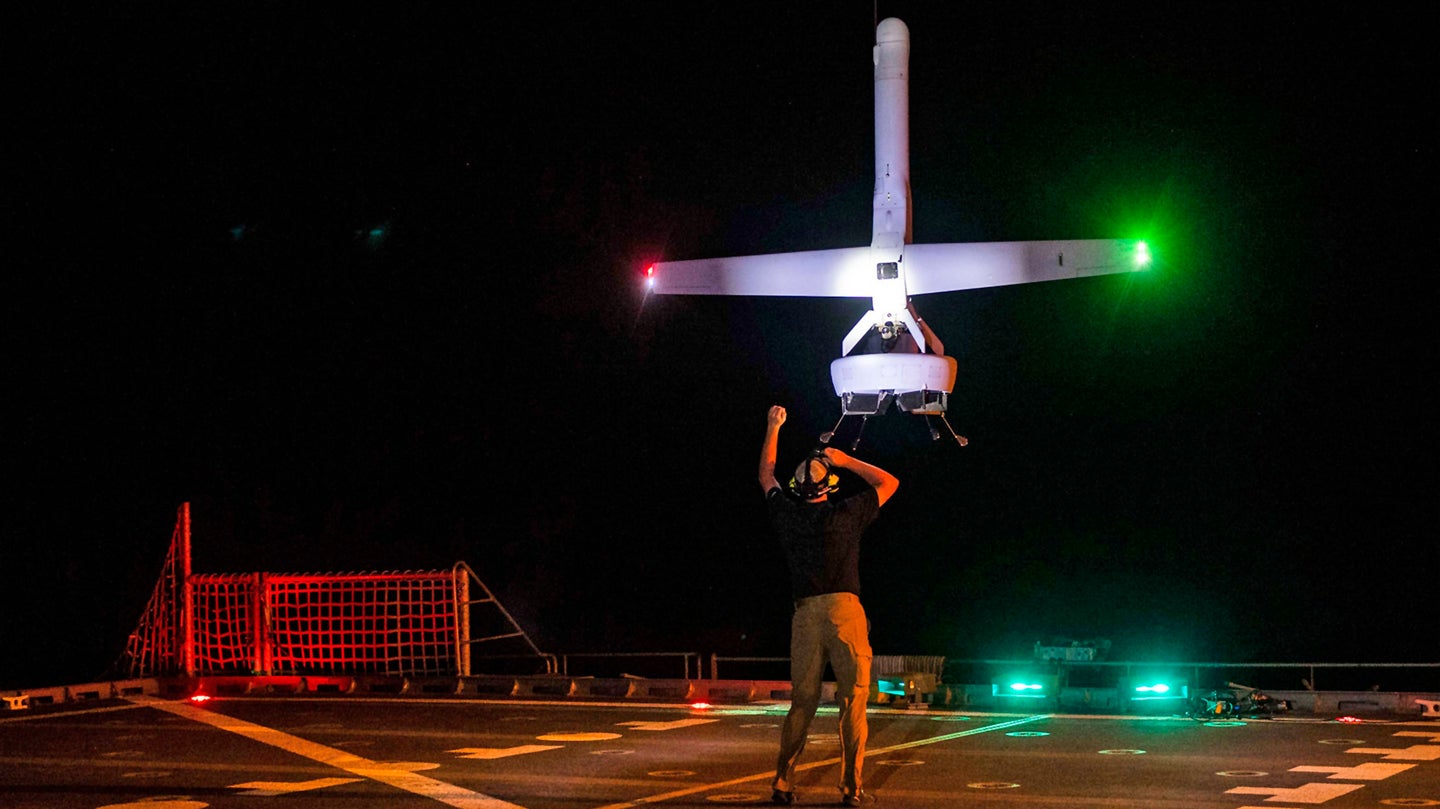
The V-Bat is getting a revolutionary AI brain, swarming capabilities, and there are plans to increase the drone's ability to work without GPS.
Artificial intelligence firm Shield AI will pair its powerful autonomy technology with the V-Bat drone, which takes off and lands vertically without the need for special infrastructure, potentially leading to a significant leap in the unmanned aircraft's capabilities, including its ability to operate as part of a swarm. The V-Bat has already been tested extensively by numerous branches of the military, and this latest news could signal that its role is set to grow as a versatile platform perfect for expeditionary missions.
The news came in a recent announcement that Shield AI had acquired the V-Bat's manufacturer, Martin UAV. Shield AI says that their proprietary Hivemind AI system is well-suited to enable unmanned aircraft to carry out a wide range of missions, and specifically lists “infantry clearance operations” and “breaching integrated air defense systems with unmanned aircraft” among them. Shield AI's autonomy systems have already been used aboard smaller quadcopter drones by U.S. Special Operations Command since 2018.
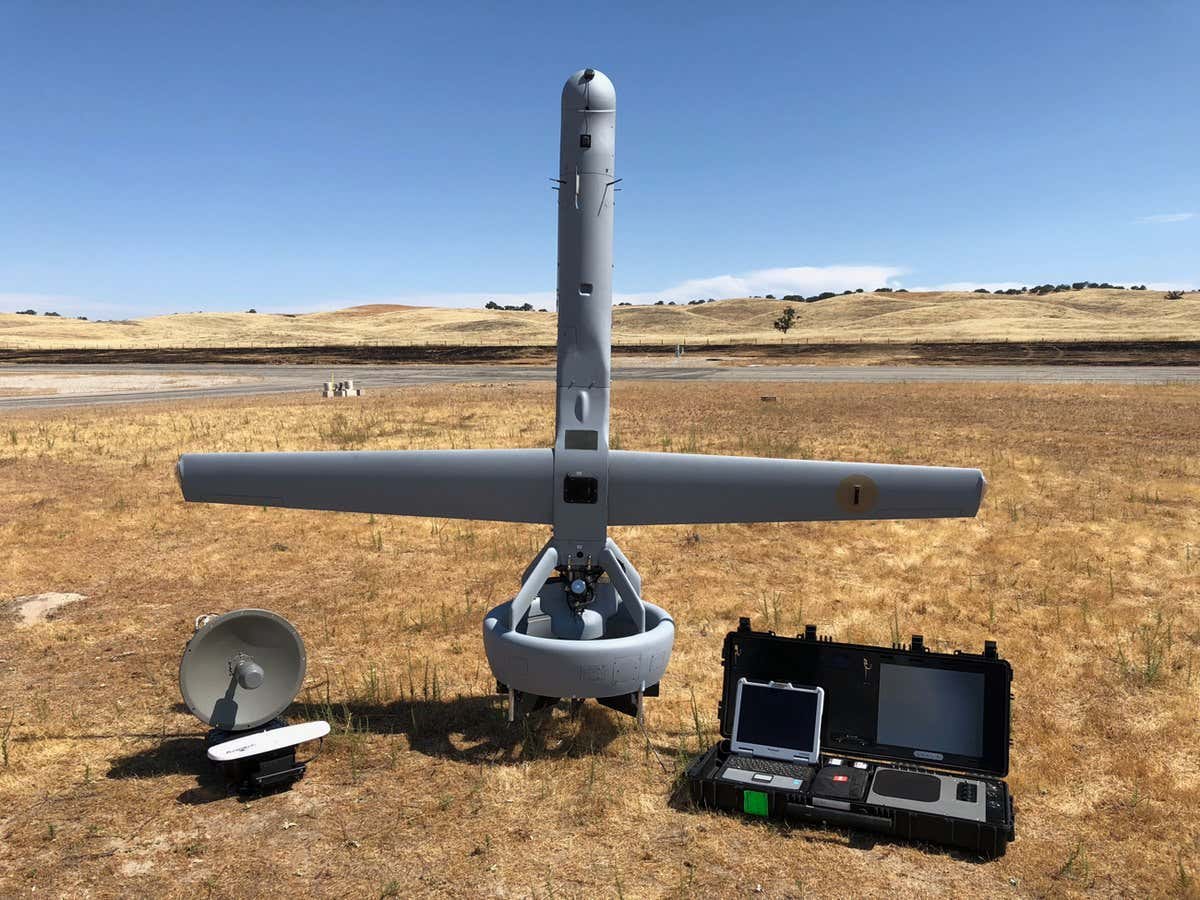
A V-Bat drone and its portable command center.
“Shield AI will integrate its combat proven autonomy software, Hivemind, into the V-BAT, reinforcing Shield AI’s leadership position in defense-focused edge autonomy,” the company’s news release reads. “The acquisition of Martin UAV complements a deliberate strategy to integrate Hivemind onto unmanned systems for defense and commercial applications.”
In the release, Brandon Tseng, Shield AI cofounder and former Navy SEAL, describes the V-Bat in three words: “Expeditionary. Intelligent. Collaborative.” Tseng says that the combination of Shield AI’s autonomy technologies and the V-Bat’s unique capabilities represents “the future of unmanned aircraft,” allowing unprecedented levels of coverage even in “high-threat environments” and enabling the drones to “make their own decisions to execute commander’s intent to accomplish missions.”
This latest press release also claims that Shield AI’s proprietary autonomy system will ”enable GPS- and communications- denied operation.” Reuben Martin, CEO of Martin UAV, elaborated on what that could mean for the battlefield of the future, noting that “GPS and communications on the battlefield are no longer assured. A great aircraft without an AI to make intelligent decisions will be sidelined against China, Russia, and an increasing number of adversaries who are fielding electronic warfare and anti-air systems.”
On Shield AI's webpage for their Hivemind AI system, the company goes further, stating simply "No GPS, No Comms, No Problem," claiming the AI system can "Remove the need for human operators, GPS, and RF [radiofrequency] links."
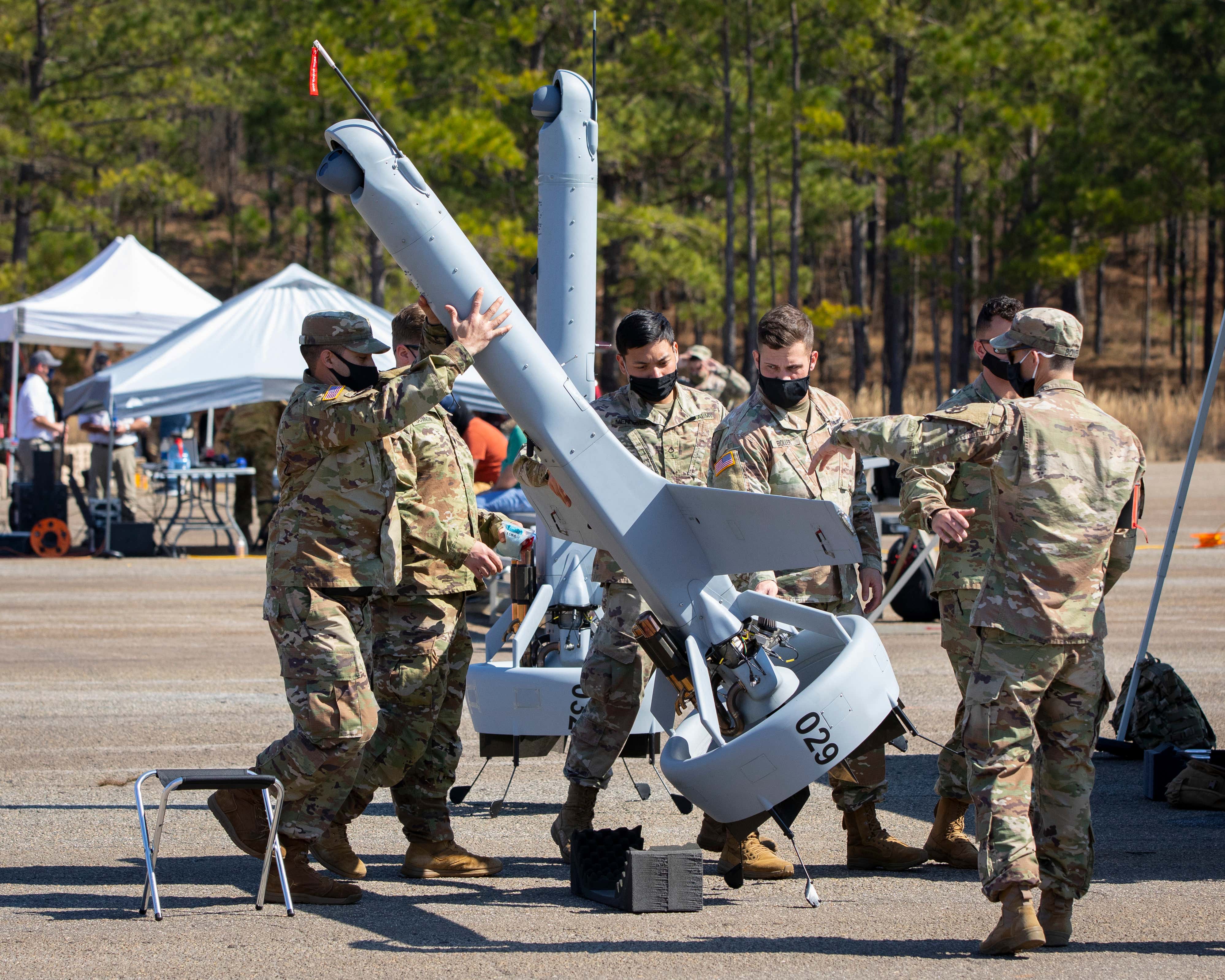
The Army Futures Command's Future Vertical Lift cross-functional team is
seen here conducting V-Bat flight tests in February 2021 at Leyte West
Airfield, Fort Benning, Georgia.
The V-Bat measures just nine feet in length with a wingspan of just under 10 feet and combines the low footprint required for vertical takeoff and landing (VTOL) operations with the high efficiency of a fixed-wing platform. The drone can take off or land in a nine-square-meter area independent of special infrastructure, making it perfect for crowded urban environments, expeditionary operations in austere areas, or the decks of surface ships. Being able to operate UAVs and other aircraft in GPS-denied environments is becoming a larger priority for the Pentagon, as is the ability to operate in austere or unprepared locations, both of which the VTOL drone aims to do.
The V-Bat can be transported in the bed of a pickup or inside a UH-60 Blackhawk helicopter and weighs just 125 pounds. A two-person crew can have the UAV up and running in less than a half-hour. A laptop-based user interface built into a portable hard case rounds out its impressive portability capabilities.
The drone runs on a 183cc two-stroke engine powering a ducted-fan propulsion and control system, enabling it to reach a top speed of around 90 knots and altitudes as high as 20,000 feet. Martin UAV claims the V-Bat has an 11-hour endurance and can carry payloads up to 25 lbs, making it well-suited to carry a wide variety of multi-spectral sensor systems, electronic intelligence gear, radar systems, electronic warfare suites, and communications packages. The truly modular nature of the V-Bat makes it quite useful for swarming operations, as different drones could be configured with various payloads to give an entire swarm the flexibility to carry out multiple missions and be rapidly reconfigured. It's unknown if there are any plans to arm the drone, but considering its payload capabilities, it's possible the VTOL platform could become an optionally reusable cruise missile or loitering munition in the future.
A line-of-sight datalink gives the V-Bat roughly 50-mile range, although that is largely impacted by terrain. Its range could potentially be augmented with forward-based ground control stations or through relay links to other airborne craft. When operating in a fully autonomous mode, these lines-of-sight datalinks wouldn't be as much of a factor and would allow the drones to travel even farther. Even connecting V-Bat with operators via a basic low-bandwidth satellite datalink, so it can provide simple updates for monitoring and accept simple commands, could be an option.
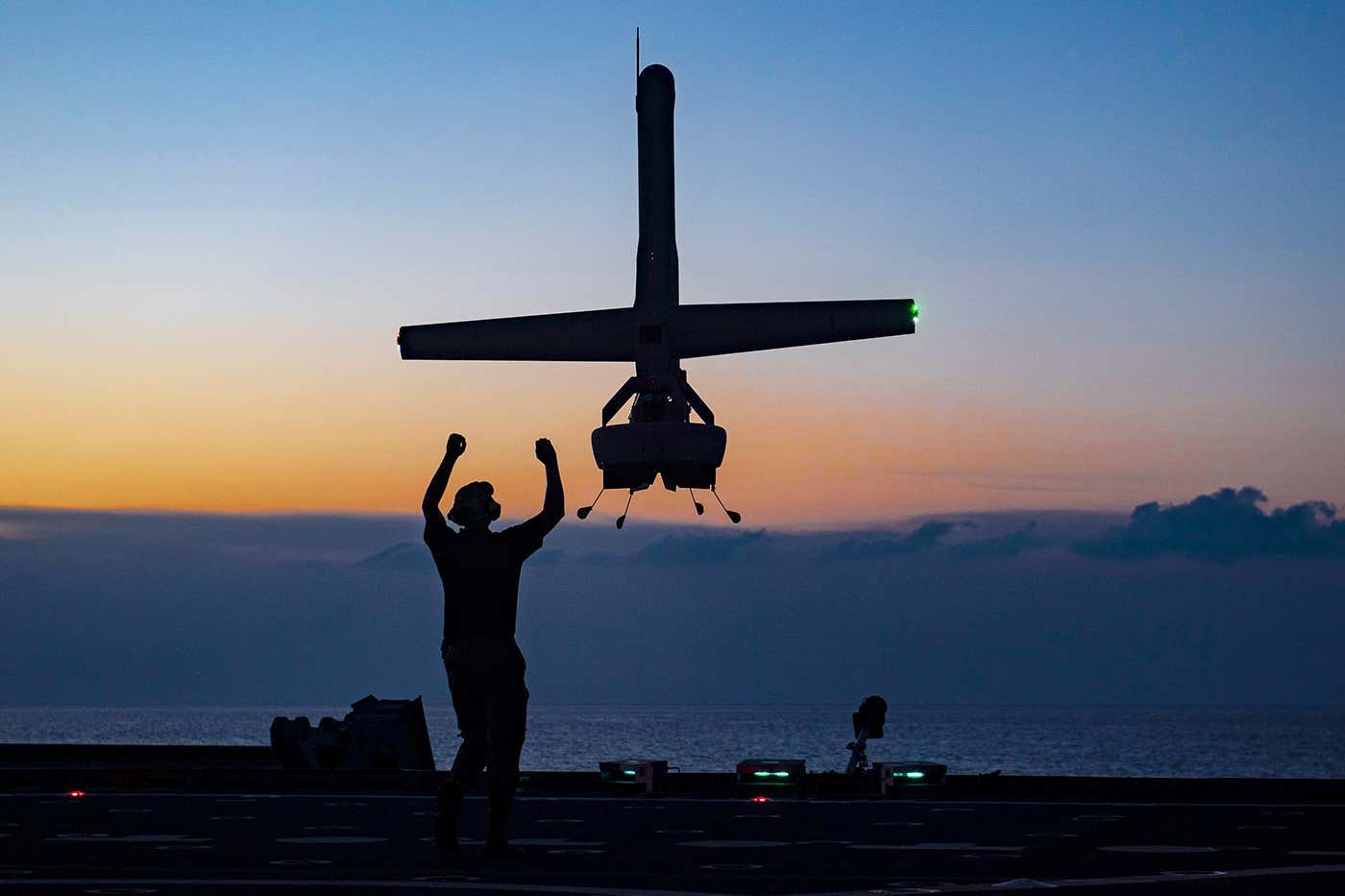
The V-Bat has already been used in counter-drug operations by the U.S. Navy, while the Marine Corps has been testing the VTOL drone for future use to replace aging UAV systems. The unique UAV was also recently chosen as a finalist in the Navy’s Mi2 Challenge, which seeks to “accelerate the identification and evaluation of Unmanned Aerial Systems (UAS) capable of operating in austere deployed environments without ancillary support systems.” The U.S. Army, meanwhile, is eyeing the V-Bat for future use as part of its Army Expeditionary Warrior Experiment which seeks out "concepts and capabilities at the lower tactical echelon in support of Multi-Domain Operations (MDO)." The drone is competing against three other UAVs to replace the Army's RQ-7 Shadow, which is rapidly approaching obsolescence and does not have anywhere near the capability set the V-Bat does.
Shield AI also recently acquired Heron Systems, makers of the AI systems that went undefeated in the AlphaDogfight virtual air combat trials against human pilots. It was just recently announced that the same AI “pilot” would be integrated into an L-39 Albatros jet trainer for real-world air combat testing. It's unknown if that same AI, or some version of it, will be integrated into the V-Bat in the future, but Shield AI's announcement states that the AlphaDogfight "AI pilot" system would be incorporated into various unmanned aerial systems.
Above all, the capability to launch and land swarming drones of substantial size and capability with minimal infrastructure could really be a decisive factor in future conflicts. Drones like the V-Bat that offer such a unique blend of capabilities could create a near-impenetrable intelligence, surveillance, and reconnaissance network over areas of the battlefield, enabling new levels of situational awareness and data sharing.
Brett Tingley
Forget Extraterrestrials: What if UFOs Were Piloted by Dolphins? ( The Debrief )
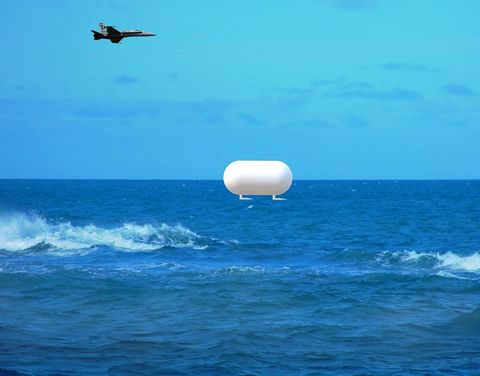
Crazy? Perhaps... but hear me out.
Earlier this year I was taking part in a panel discussion involving UFOs when the inevitable subject arose of where they are coming from and who, if anyone, is piloting them. Because I’d already been engaging in something of a thought experiment on the subject, I decided to test it out on the other panelists and it’s since taken on a life of its own, at least in my social media timeline.
“Some people believe it’s the Russians or the Chinese,” I said. “It’s not. Others think it’s aliens. It’s not aliens. It’s dolphins,” I continued. “If we ever catch one of those tic tacs and cut it open, it’s going to be full of salt water and there will be a dolphin inside wearing some sort of telekinetic helmet.”
Certainly I was partly tossing the idea out there for humorous value, but not entirely. Crazy? Perhaps. But bear with me for a moment and I just might change your mind.

HOW WOULD AN UNDERWATER MAMMAL CONSTRUCT A STARSHIP?
Well, that question jumps too far ahead in the discussion without establishing the required groundwork. Let’s start with something more basic. Would dolphins even be capable of grasping such advanced concepts?
We know from the fossil record that dolphins (known as Pakicetus) walked on the land roughly 50 million years ago before returning to the ocean to re-evolve toward the shape we see today. Even then they had a massive brain case. Dolphins today have the largest brains of any animal when measured as a percentage of their total body mass.
At this point you might be wondering why these genius dolphins with amazing skills don’t talk to us. Look at what we’re doing to the oceans. For that matter, look at what we do to the dolphins. How many of them wind up in tuna cans? I don’t find it all that surprising that they might have no interest in chatting with us or helping us out.
Also, dolphins have a complex language. But after more than a century of trying, we still haven’t managed to exchange a single question and answer with them. Who are the real dummies here?
EVEN IF IT’S POSSIBLE, THAT’S STILL A PRETTY BIG LEAP TO MAKE
Perhaps so. But let’s consider the alternative explanation being presented. Extraterrestrials from Zeta Reticuli? One of the first arguments raised by skeptics of the extraterrestrial hypothesis is that the gulf of interstellar space is too vast to navigate. No problem for the dolphins. They were already here.
And why are the dolphins so horney? They’re always trying to have sex with human women in pools. Could it be part of their hybrid breeding program? Admit it… now you’re starting to think about it.
Every year we lose hundreds if not thousands of swimmers and sailors who simply disappear. Sure, most of them probably just drowned or were eaten by sharks. But if the dolphins had some sort of human abduction and experimentation program going on, that’s the perfect cover story.
BUT WHY? WHY WOULD THE DOLPHINS WANT TO GO TO SPACE?
I don’t know, Einstein. Why do you want to go to space? It’s not as if they aren’t aware that there is something above the top of the water. Remember, they used to live on the land. They once looked up at the stars also. Surely a species with that much brain power had to wonder what was out there in the darkness. And they would realize that they would have to develop technology to find out.
Without the benefit of hands and opposable thumbs, the dolphins would need to figure out some other way to manipulate materials to build things. We regularly hear stories from experiencers who claim that extraterrestrials are able to move objects (and abductees) through walls using some form of telekinesis. If you can do that, you could build things as well. Of course you’d probably need a huge brain and tens of millions of years of evolution to master something like that. Oh, wait…
Huge brains. A 45 million year head start. A vast, deep ocean to conceal themselves in. Are you still certain that it’s the grays or the reptilians cruising around near our nuclear facilities?
SO YOU SERIOUSLY THINK THIS COULD BE TRUE?
Not really. But that was the entire object of the thought experiment in the first place. Talking about UFOs and who or what might be piloting them (if they are piloted at all) is fascinating for so many of us. I love the subject. But until someone produces a body or some other incontrovertible evidence, every theory anyone puts forward comes with a significant number of assumptions and unknowns.
When it comes to the extraterrestrial hypothesis, that statement remains 100% accurate. (With apologies to all of your experiencers out there. I don’t have the benefit of such first-hand knowledge.) And for every point being made about alien intelligences and how they could be responsible, you can make an equally compelling argument that the dolphins are responsible. In some cases you can make an even more compelling argument.
Centinaia di video con UFO: tensioni tra Pentagono e ufologi ( SPUTNIK )

“Ci guardano come se fossimo ritardati”
Testimoni pazzi
Una tecnologia per noi ancora inarrivabile
Relazione dai militari
Thursday, July 29, 2021
General Atomics Unveils New "LongShot" Aircraft-Launched Air-To-Air Combat Drone Rendering ( The War Zone )
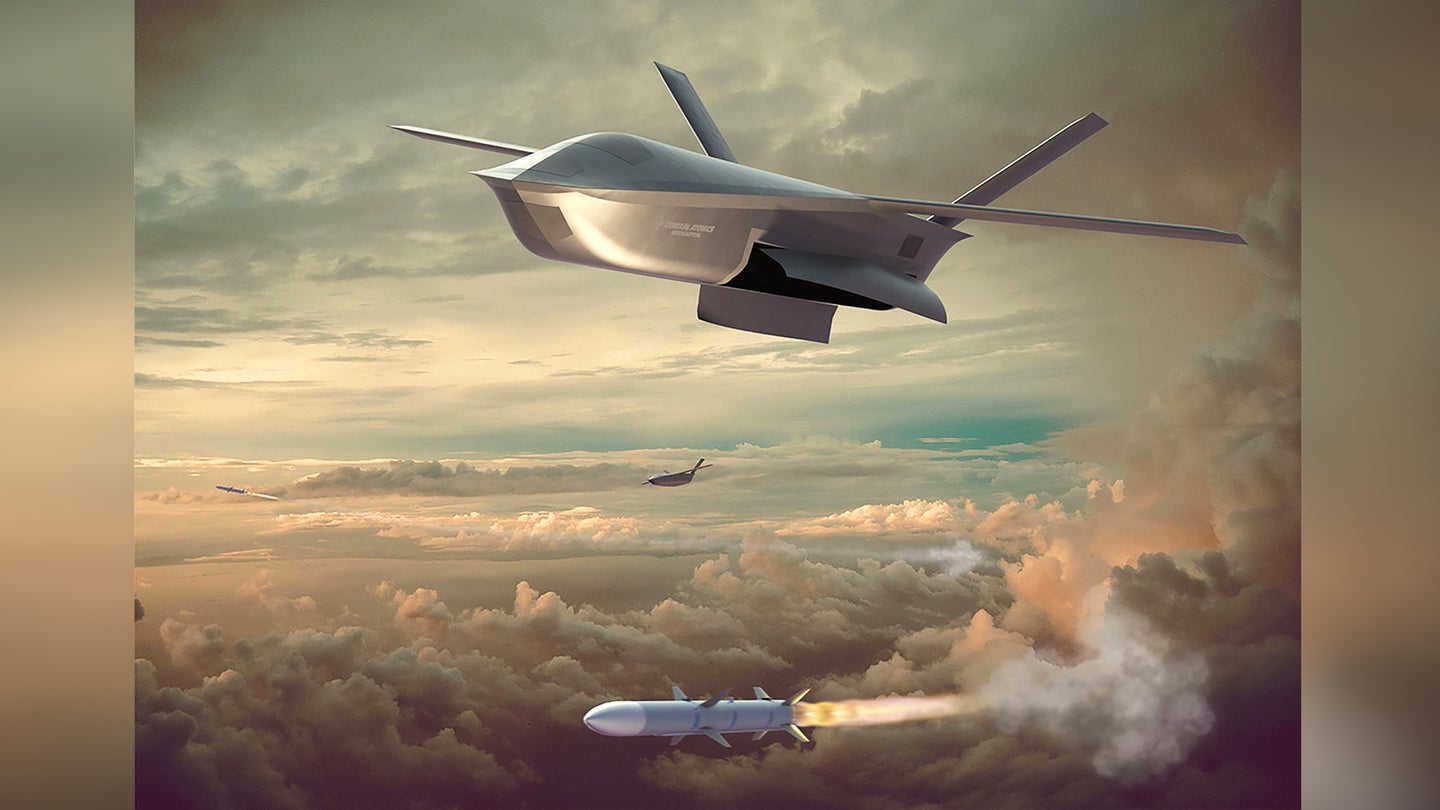
LongShot is an initiative to give combat aircraft their own drone able to fly out and engage enemy aircraft over long distances with its own missiles.
General Atomics Aeronautical Systems, or GA-ASI, has revealed for the first time an artist’s impression of a missile-carrying air-to-air combat drone that it is developing as part of the Defense Advanced Research Projects Agency’s LongShot program. GA-ASI, as well as Lockheed Martin and Northrop Grumman, is working on this project, which calls for an unmanned aircraft that can be launched in mid-air from a manned aircraft before flying into potentially more hazardous environments and engaging aerial threats using its own missiles.
The latest artwork, seen at the top of this article and initially revealed in a recent article on the GA-ASI website about small unmanned aircraft systems, or SUAS, shows a stealthy-looking drone with a prominent chine around the center of its fuselage, the line tapering to meet a high-mounted fixed wing that apparently has only moderate sweep. There is a prominent V-shaped tail and we can see a weapons bay on the side of the rear fuselage, with two doors, but it’s not clear if there’s a symmetrical one on the opposite side.
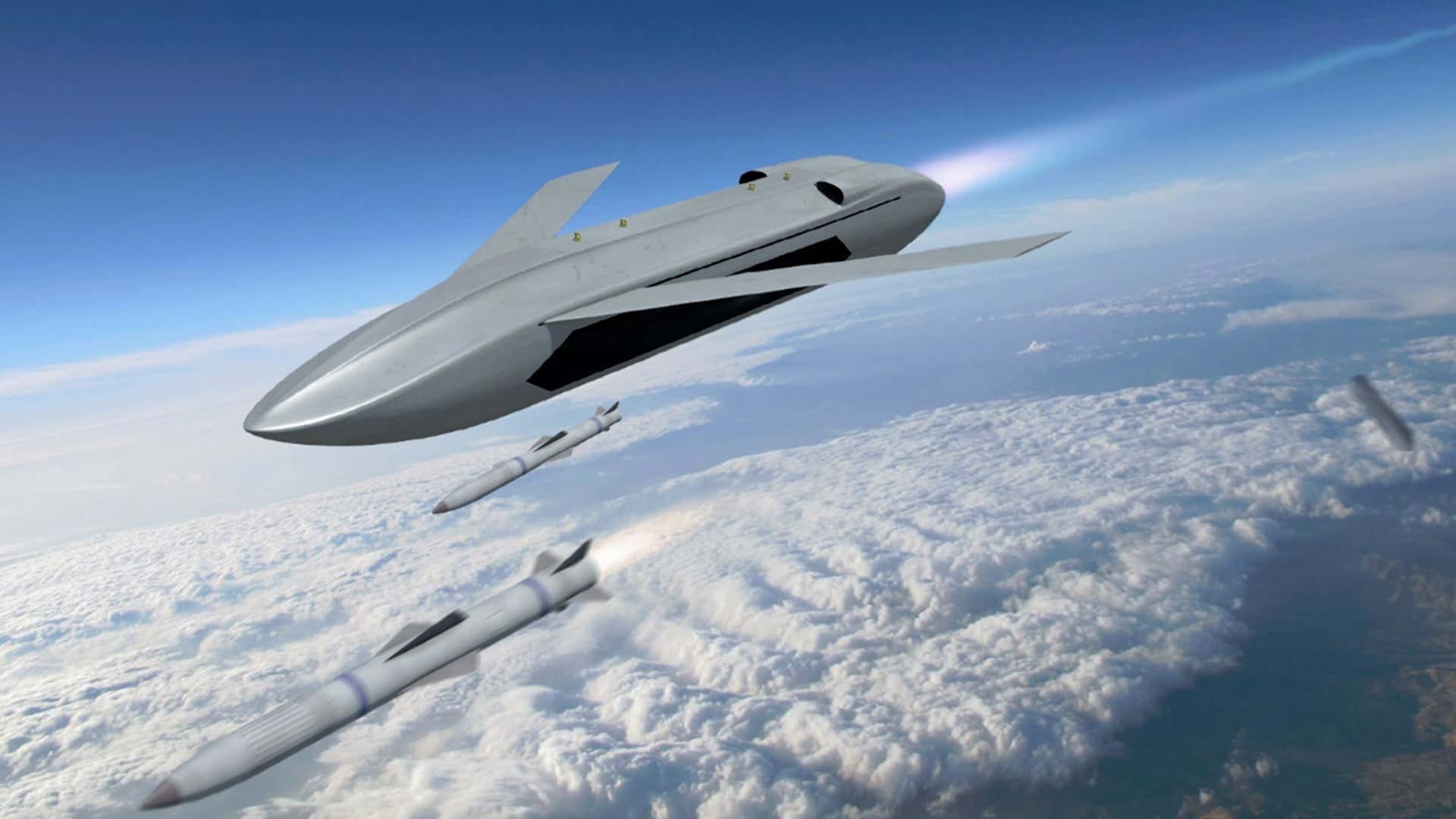
A previous DARPA concept showing one LongShot concept.
It’s hard to gauge the size of GA-ASI LongShot, although it’s clearly big enough to accommodate radar-guided air-to-air missiles, including what appears to be an AIM-120 Advanced Medium-Range Air-to-Air Missile, or AMRAAM. With that in mind, it’s notable that the LongShot concept artwork from DARPA and Northrop Grumman both showed what appeared to be new, smaller-sized AAM designs. Various panels around the airframe could be meant to represent conformal antennas for onboard sensors, but it is hard to say for sure.
The powerplant cannot be immediately determined, but it would appear to be a rear-mounted turbine. This would reflect DARPA’s own LongShot concept art, showing a stealthy cruise missile-like vehicle, with pop-out fins. Overall, however, both the GA-ASI and Northrop Grumman LongShot concepts depict drones that are much more “aircraft-like” than the DARPA artwork, which seemed to have more in common with a cruise missile or remote carrier.
GA-ASI also provides more details about how the company expects the LongShot to be employed in combat, describing a “small system” that “will help clear the way through the skies,” and that will “charge into hostile airspace armed with its own air-to-air missiles, able to fire on enemy targets if it were so commanded.”
“It could initiate a fighter sweep ahead of a strike wave without putting a human crew in danger, or it could join an attack alongside the vanguard with human-crewed warplanes.”
All this certainly fits in with our understanding of the LongShot thus far, as a means of extending the reach of the launch platform in aerial combat, while also reduce its vulnerability to hostile aircraft or air defenses.
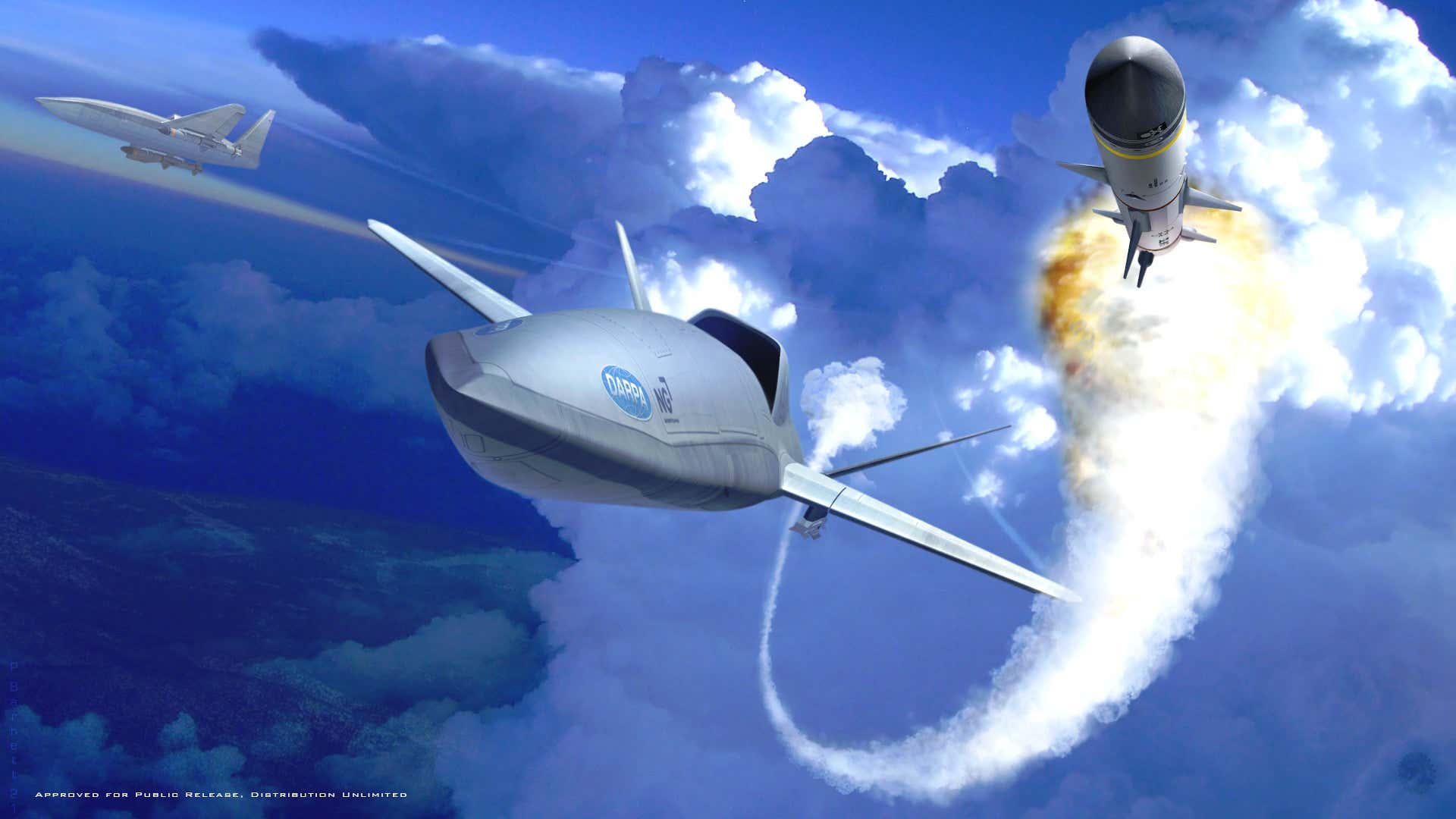
Northrop Grumman’s LongShot concept, revealed earlier this year.
The company mentions that LongShot could be launched from either a manned aircraft or from a larger drone and that one option would be for it to be carried by bombers, providing them with a “potent new anti-air capability.”
In the bomber-launched scenario, the LongShot is described as being launched after “allied battle networks” detect hostile fighters, rather than its launch necessarily being commanded based on what the bomber's own sensors 'see.' In this way, the LongShot would stand in for a manned fighter escort, protecting the bomber and allowing fighters to be tasked with other missions.
While adding LongShot to legacy bombers, such as the B-52H, is a clear goal, also integrating it with the upcoming B-21 Raider stealth bomber, and making it so that it can fit in its weapons bay, would also be very beneficial. The Air Force has already talked about its forthcoming B-21 as potentially having air-to-air capabilities, but exactly in what manner remains undisclosed. One option could be the use of a counter-air drone system like LongShot. The Raider will have optionally manned capabilities, which could also be leveraged if it were to be employed as a possible LongShot launch platform.
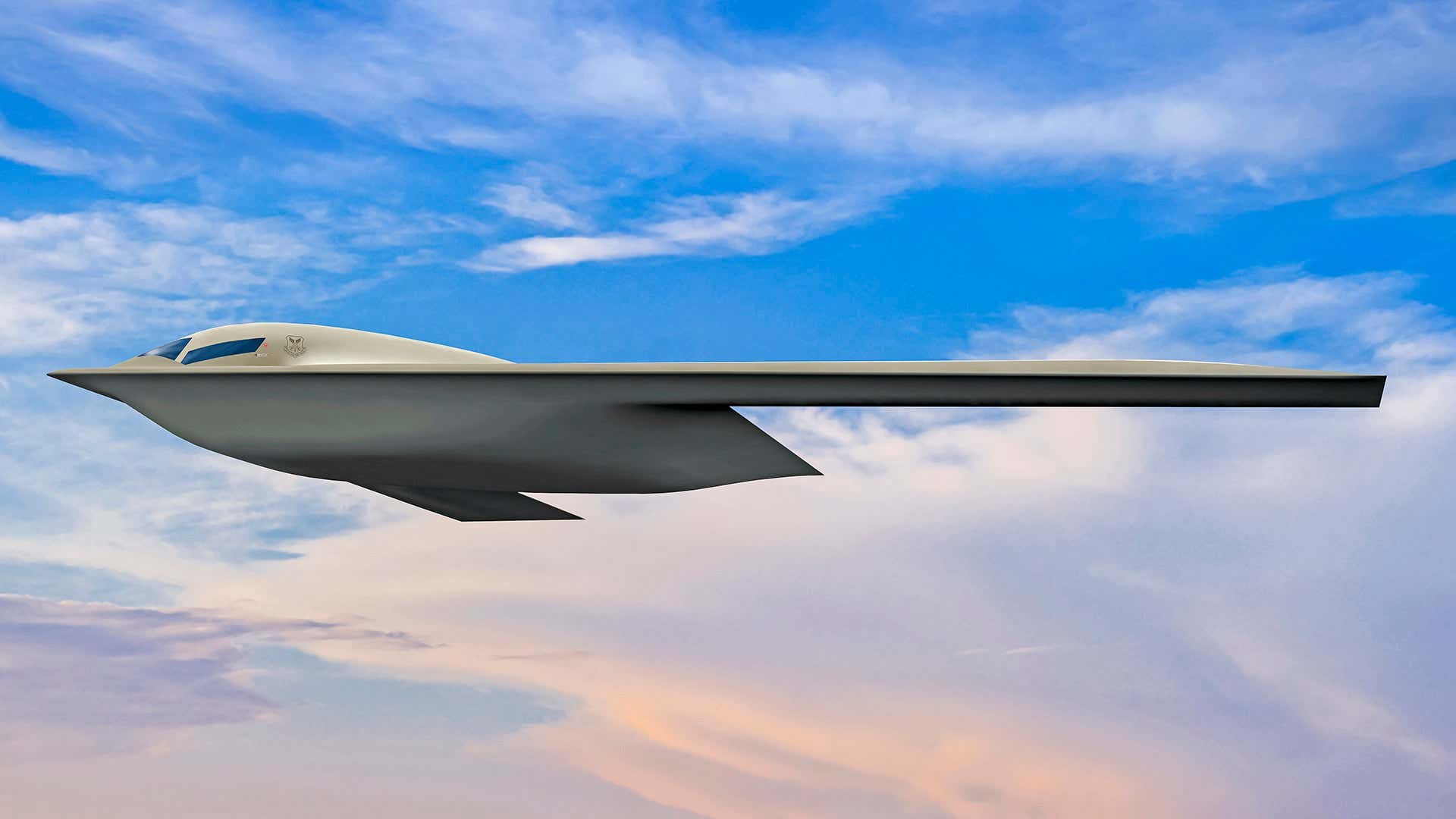
The most recent concept art of the B-21 Raider.
The LongShot program is still relatively new, DARPA only having announced the contract awards back in February, after it had been included in the Pentagon’s budget request for the Fiscal Year 2021. Before that, however, there was also work on the Flying Missile Rail (FMR) program, which aimed to explore similar technologies, with a separate focus on advanced manufacturing and rapid prototyping concepts.
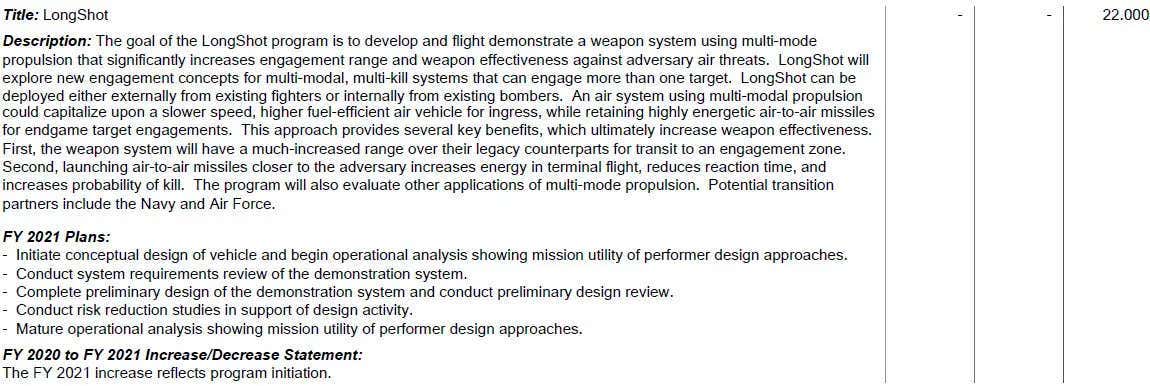
The LongShot entry from the 2021 Fiscal Year budget request.
As for LongShot, there remain many question marks around it, not least of which is what kinds of air-to-air missiles will arm it. It’s conceivable that the drone might be capable of carrying the long-range AIM-260 that is now under joint development by the Air Force and Navy, and/or a smaller-sized design like the Lockheed Martin Cuda or Raytheon Peregrine, which should allow a greater quantity of weapons to be carried, as well as the AIM-120. Considering another aircraft has to carry LongShot, size and weight will certainly be a factor, so limiting its ability to carry larger weapons may be a necessity. Regardless, the idea is that an AAM can be combined with the standoff LongShot to engage targets not only much further away from the manned aircraft or drone that launched it but also to counter different threats from a variety of vectors and leverage new and more deadly cooperative tactics.
As we have discussed before, the fact that the LongShot can launch a missile closer to the target means the weapon retains a high level of energy, making it harder for the target aircraft to escape. Having these hard-to-detect systems flying in a counter-air role will also greatly complicate the enemy's ability to defend themselves in an aerial engagement. One can imagine how it could give an aircraft like the F-15EX a massive capability boost, with the jet working as a 'quarterback,' as well as a sensor and communications node, with the LongShots heading into more deeply defended territory to take out enemy aircraft.
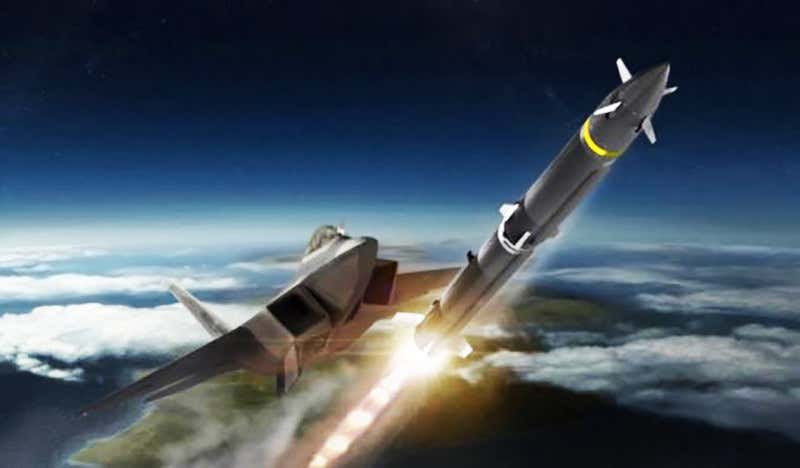
Concept art of the Long Range Engagement Weapon, or LREW, another
advanced air-to-air weapon program that Raytheon has been working on.
How the LongShot will actually cue its missiles onto a target remains unclear, but it’s highly probable that datalinks would provide targeting data, either supplied from the launch aircraft/drone, or from a wide variety of sensor-equipped platforms. On the other hand, the artwork at least does raise the possibility that the LongShot could be equipped to carry some kind of sensors of its known, but there is no confirmation of this.
All in all, LongShot seems to offer a variety of options to enhance the air combat capabilities of manned and unmanned aircraft alike, potentially with a comparatively low price tag, although so far we don’t know to what degree it’s expected to be attritable, or if, like some of GA-ASI’s other SUAS concepts, it’s actually expected to be recovered and reused.
Whatever the case, the program certainly has momentum behind it, at least for now, and GA-ASI’s latest artwork provides a glimpse into exactly what this intriguing concept could look like.
Thomas Newdick
Pentagon Report Is Helping Prime Australia for Possible Future UAP Studies ( The Debrief )
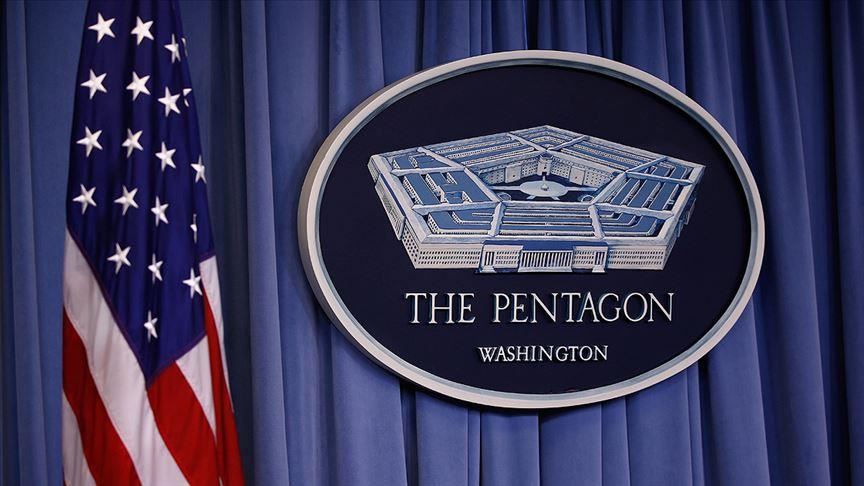
A little more skiddish to cover the topic, Australia may be getting comfortable with UFOs.
With the renewed interest in unidentified aerial phenomena (UAP) that has been seen within the last several years, a recent report released by the Pentagon regarding the phenomenon has resulted in increased media attention, in addition to individuals of high standing taking more interest in the subject.
The 180 Day report released on June 25th, 2021 has seen the Pentagon declare the government’s involvement in researching and reporting on UAP in a far more involved capacity than had been previously admitted. The report itself sheds some light on important points, which include the matter of potential aerial threats to national security which thereby acknowledges the existence of something beyond their grasp.
Without sufficient context or other information provided with the specific reports that were analyzed, many cases fall into the “unknown” category, which has led to some frustration in the general public. “A smoking gun” cannot be expected by these bodies simply for the fact that there isn’t enough corroborating evidence to say with certainty what these UAP are. Instead, we have seen more media outlets report on these instances in a much more serious light which in turn creates a much safer, more inclusive arena for witnesses to come forward and indeed keep the conversation going.
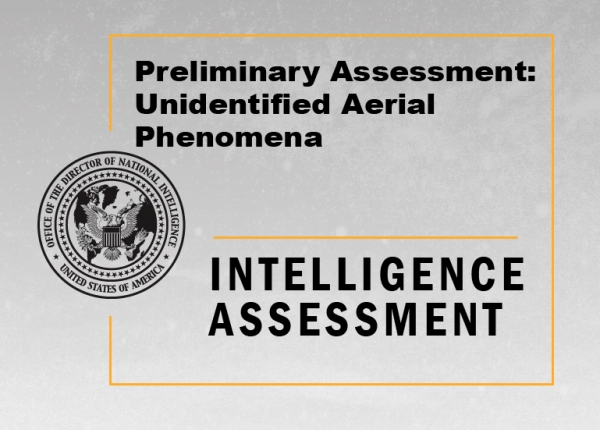
Credit: ODNI/Public Domain.)
In preparation for the Pentagon report, Australia’s Channel 7 aired a prime time special in June which delved deeper into sightings and experiences witnessed by countless Australians over the last few decades. The story itself, developed by Australian journalist and author Ross Coulthart, was received well overall, with some viewers taking to social media to share their own stories. Among them, Australian media veteran Grant Denyer told of his experience witnessing a UFO in Melbourne’s South East when he was just 19.
According to Denyer, he “noticed a couple of very strange lights just hovering in the sky… and they were too bright to be stars or planets.” Denyer told Channel 7 that the dots of light were “about as bright as a plane but not moving at all”.
Following the release of the unprecedented Channel 7 story, many Australians took to the news outlet’s social media pages to recount their own stories in support of Denyer’s openness. It’s hard to say whether this Pentagon report was the catalyst to bring forward countless witnesses or whether it was simply a prompt for others to feel safe sharing their story, one thing is for certain, it was a key milestone in the reporting of the UAP subject and one that will snowball for years, if not generations to come.
Knowing that witnesses are able to feel somewhat validated in their stories and experiences is in itself one of the more important things to unfold from the release of the Pentagon report. Over the years, Ryan Sprague of Somewhere in the Skies podcast has released several books in which he retells witness stories and experiences, prompting the public to take witness testimony seriously.
Following the release of both the Pentagon 180 Day Report and the Channel 7 prime time special, the shift in mentality has been noticed across the broader media. There are less X-Files themed music specials when a report is shown on the news and a more serious approach has been taken to report on new UAP accounts.
Irrespective of what the future looks like with regards to reporting of UAPs by the Pentagon and other government bodies, the importance of what has come from the 180 Day Report cannot be undone. With the government now providing validation on a national and indeed a global scale, Australia and other hesitant countries may be ready to accept the UFO phenomenon as something worthy of rigorous study.
Violeta Matijevic Bagia
Will we ever get to see Neill Blomkamp’s mooted District 9 sequel based on ‘American history’? ( The Guardian )
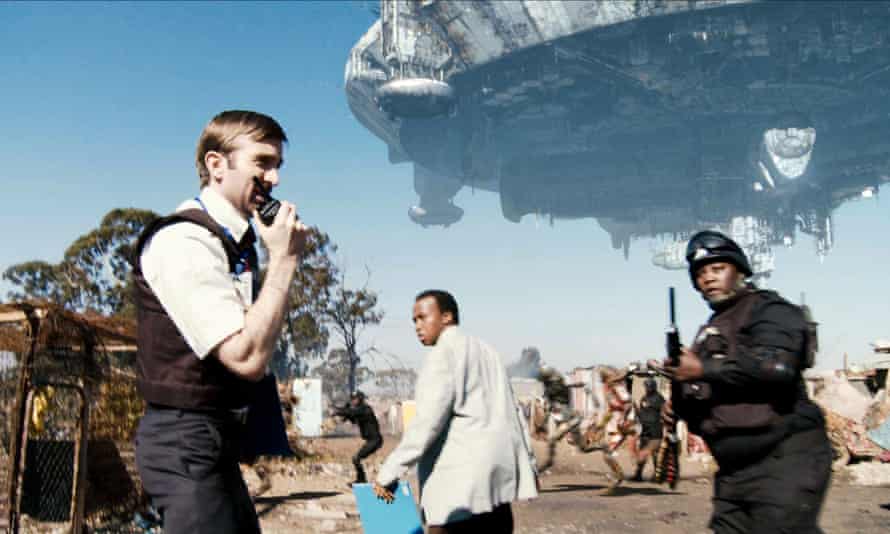
Blomkamp’s dystopian satire left so many questions unanswered that it simply demands a follow-up – and recent US politics could be the perfect inspiration
The greatest science fiction movies always leave us wanting to know more. Think Alien, 2001: A Space Odyssey, The Terminator, Blade Runner, Ex Machina or The Matrix. All are spiked with so much enigma – visions of the future that are only half-explained – that we finish the movie desperate for more information. Was Deckard a replicant? Who built and placed the monoliths? Where did the xenomorphs come from? Should Neo have taken the blue pill? These are the kinds of questions that fuel message board speculation for decades after the movie hit cinemas.
Neill Blomkamp’s District 9 stands up to any of the movies mentioned above in terms of its ability to create a living, breathing science fiction world that both wows the senses with its shocking differences from our own reality and inspires us to look at the inadequacies of our own societal structures. Blomkamp’s ingenious decision to blend the then-fresh found-footage style with racial satire amid the rancid slums of alternate reality South Africa marked out the 2009 film as a rare example of intelligent science fiction on the big screen. It put Sharlto Copley on Hollywood’s radar and briefly saw the director take on the mantle of coming man of futuristic cinema: the middling Elysium followed in 2013, with the underrated Chappie arriving in 2015, but, despite the latter returning us to the mean streets of Jo’burg, Blomkamp’s star never quite recovered its early sparkle.
Now it appears Blomkamp is returning to his breakthrough film. Earlier this week, the director told IGN that District 10 would take cues from “a topic in American history”, adding: “That script continues to be written. It’s looking good. It took a decade to figure out, to come up with a reason why to make that film as opposed to just make a sequel.”
The worry is that after failing to get his Alien project made, the South African film-maker no longer has the clout in Hollywood to get this one over the line – which would be a huge pity. We all want to know what happened to Copley’s callous functionary turned defender of the alien “prawns” Wikus van der Merwe after he was transformed into one of the creatures he once casually persecuted during the events of the original movie. District 9 left so many questions unanswered that it simply demands a follow-up.
Will the extraterrestrial Christopher return to help restore Wikus to his old self? What happened to the prawns left behind on Earth? And will the nasty humans who kept their unfortunate guests in squalor be blasted to smithereens now the aliens have regained control of their heavily weaponised mothership?
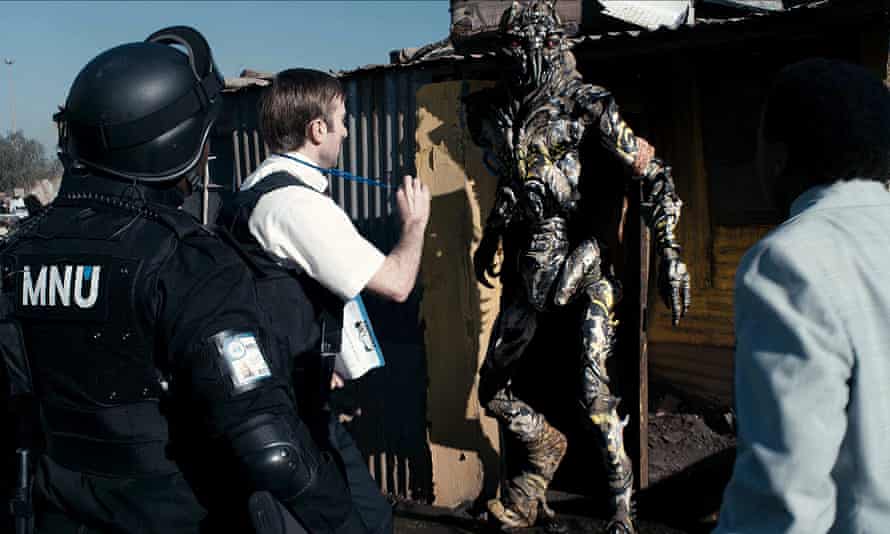
Holding a mirror up to society ... District 9. Photograph: Allstar/Sony Pictures Releasing/Sportsphoto Ltd
There are other questions to answer. Why did Wikus transform into a prawn after coming into contact with the aliens’ fuel in the first place? What the bejesus is in that stuff?! Why were some of the extraterrestrials intelligent, while others appeared more animalistic in intellect? Do the aliens function using something akin to a hive-mind (there were hints in District 9 that they may have crash-landed on Earth due to the death of their “queen”) or are they more individualistic, and therefore human, in terms of their approach?
Ben Child Geek
The idea that District 10 could be based on a moment from American history doesn’t seem to quite tally with the film’s likely Jo’burg setting – the film’s title refers to the new area where the remaining Earthbound prawns were moved to at the end of the first film. Apartheid South Africa’s grimy maelstrom of inequity and prejudice was such a perfect jumping off point for a dystopian satire on xenophobia that it’s hard to imagine a sequel working so well in a different location, even one that has the potential to represent an equally poisonous echo chamber.
On the other hand, while 1980s Jo’burg was a scary place, its citizens didn’t try to storm their own apex of government to try to overturn an election after being riled up by an authoritarian demagogue. There’s an argument that recent US history is more dystopian than anything Hollywood sci-fi film-makers have ever produced on the big screen, though, luckily for American democracy, Donald Trump’s rightwing mob were unable to get hold of as many meched-out exo-suits.
Gli studi di Harvard - Progetto Galileo È caccia agli alieni ( QN )
A caccia di alieni con il Galileo Project:
è l’obiettivo del nuovo progetto guidato da Avi Loeb, dell’università di Harvard, noto anche al grande pubblico per i suoi studi sul misterioso visitatore spaziale Oumuamua e la Breakthrough Initiatives per lanciare sonde verso i più vicini pianeti extrasolari.

L’operazione, nata da contributi liberi, ha raccolto quasi 2 milioni di dollari ma l’annuncio del programma è stato accolto con un certo scetticismo da una parte della comunità scientifica. Ci sono elementi che offrono indizi interessanti da vari fronti e "non possiamo più ignorare la possibile esistenza di civiltà tecnologiche extraterrestri": è questo in sintesi il concetto che anima il nuovo ambizioso progetto promosso da Loeb. Tra gli ‘indizi’, l’enigmatico oggetto celeste Oumuamua, un asteroide o cometa dalla strana forma a sigaro.
Tuesday, July 27, 2021
Suggestions for Congress on the UAP Issue - ( Christopher Mellon )

Had the U.S. intelligence system been working properly, Congress would have been aware that unidentified aircraft were habitually penetrating sensitive U.S. airspace decades ago. Certainly, at a minimum, they would have been informed no later than 2015 when encounters off the East Coast of the United States were occurring on a near-daily basis.
Unfortunately, Congress only learned of the issue in December 2017, after a couple of determined former USG officials were able to release compelling DoD UAP videos to the New York Times and then introduce some intrepid Navy combat pilots to the Senate Armed Services and Intelligence committees. Those briefings led to a Senate Intelligence Committee request for an official assessment of the UAP issue by the Intelligence Community.
The resulting assessment was punctually delivered to Congress by the Director of National Intelligence (DNI) on June 25th, 2021. It confirmed what Lue Elizondo and I had been shouting from the rooftops for several years: Namely that there really are a variety of mysterious, highly advanced unidentified aircraft operating in restricted military airspace. Although the unclassified report didn’t expressly say so, those privy to the classified version of the report confirms that some of these vehicles demonstrate capabilities beyond our understanding. As Senator Mitt Romney stated after reviewing the classified information: “I don’t believe they are coming from foreign adversaries, if they were, why, that, would suggest they have a technology which is in a whole different sphere from than anything that we understand.”
To date, DoD and the IC have both been relying on a small group known as the UAP Task Force (UAPTF) for gathering and assessing UAP information. The Task Force seems to spend most of its time soliciting and cataloging UAP reports and briefing interested policymakers. There is no sophisticated technical analysis unless on occasion another organization offers it. It seems doubtful the Task Force has the skills needed to prepare a systematic UAP collection plan or the heft necessary to persuade senior officials to allocate collection times for busy satellites and other heavily tasked “national technical means.” Following its UAP report, the Task Force might have been able to develop a plan for a more capable and enduring UAP investigative organization, but that task was assigned to the Undersecretary of Defense for Intelligence (USDI) by the Deputy Secretary of Defense. Specifically, USDI has been directed to establish UAP collection and analysis procedures and the organizational and funding requirements needed for an enduring organization to succeed the UAPTF.
Admittedly, applying the term “Task Force” to the recent UAP effort has always been generous if not fanciful. At the outset, the Task Force merely consisted of a Senior Executive Service (SES) official working part-time with an assistant. They had no funding, even for travel. As time passed, the SES was replaced by a lower-ranking GS-15, reportedly for administrative reasons, but the appearance to some was a further downgrading of the UAP effort. Thanks to the Navy, the Task Force did in time acquire some additional personnel, but it has never been more than a handful of people lacking the time or resources needed to do much beyond catalog UAP incidents, answer Congressional inquiries, and provide briefings.
We won’t know for some time how fully the services and agencies complied with the UAPTF’s requests for information. Undoubtedly, some information was not shared due to bureaucratic oversights or lethargy or inadequate security clearances held by UAPTF members or the nearly ubiquitous resistance security personnel have to sharing information they control. It would be very helpful for the Task Force or its successor to have a complete list of the organizations that contributed and a POC for each. Congress should consider using directive language to ensure that, going forward, the Task Force or its successor will have a list of relevant programs and organizations and a POC for each. Similarly, for reasons that are not clear, the USAF is denying airmen the right to contact the Task Force directly to report sightings. Banning this practice is also worth considering, especially given that we know from surveys that the vast majority of UAP incidents have gone unreported due to the stigma surrounding the issue. USAF pilots who fear retribution from their chain of command should be able to speak with the Task Force if they want to. The Air Force’s long history of squelching and distorting UAP information is such that any efforts on its part to impede the flow of information on the UAP subject should not be tolerated. Similarly, there are reports that Air Force OSI agents are trying to squelch UAP conversations on highly classified communications networks among cleared personnel. Firing or demoting those responsible would be more effective than issuing a memo banning the practice.
In that regard, surveys demonstrate that fewer than 1 in 10 civilians report their sightings. The ratio in the military may be even worse; so the number of actual military incidents since 2004 is certainly far higher than the 144 reported, quite likely in excess of 1000 incidents. NORAD alone typically has hundreds of unidentified tracks every year, and few if any of those were included in the UAP report, so the actual number of cases has to be much higher than 144. Lue Elizondo and I have had the same experience interviewing military personnel – rarely did the witnesses report their encounters due to fear of the potential impact on their reputations and careers.
In light of the stigma surrounding the issue, and USAF intransigence in particular, one of the first items on the agenda for both the Task Force and the oversight committees should be to determine how thorough and comprehensive the Task Force was in collecting UAP data from the DoD and IC services and agencies. Even if there are only a handful of missing cases, those cases could be game-changing depending on what activity was detected and how thoroughly the events were documented. For example, it would not take many examples of objects entering Earth’s orbit from space, then descending and maneuvering in our atmosphere, to persuade policymakers this phenomenon is something we need to pay much closer attention to.
How thorough were the services in gathering data for the Task Force? Did anyone touch base with the Global Infrasonic Detection System, which can detect meteors and rockets, to see if or how often they track UAP? What about AWACs units or the Space Fence or the mobile X-band radar etc.? Certainly, the USAF was consulted by the Task Force, but what effort did the USAF make to contact the myriad organizations within their domain that might have pertinent information? A careful accounting of the organizations and systems that had useful data will also help identify which systems are most useful for obtaining UAP information.
In addition to ensuring a full accounting, it is also important to understand what procedures the services and agencies used to identify pertinent UAP information held by their myriad various components. Different organizations will have taken different approaches and assessing the results can help the Task Force, or its successor, identify the most efficient and effective procedures for UAP reporting.
Another important housekeeping task is to determine the degree to which UAP information was withheld due to classification. The message from the Congressional staff and Task Force should be, “If our clearances are inadequate, so be it, but at a minimum the Chairman and Ranking member of each oversight committee needs to know how many sources and UAP reports were withheld due to classification.” Similarly, the Task Force Director should at least be made aware if some UAP information was withheld due to classification. Otherwise, when briefing officials at the highest levels he will not be able to advise them that other relevant information exists or where to find it.
In sum, to date, about all we can say for certain is that one or more groups interested in U.S. military capabilities are using advanced technology (in some cases so advanced we don’t understand it) to operate with impunity in restricted U.S. airspace. Our government seems to have no idea who is doing this or why, which is hardly surprising given the fact that to date no effort has been made by our government to find answers to these questions. Also, as the Task Force noted, given the range of behaviors, capabilities, sizes, and shapes observed, there is most likely more than one actor involved. In sum, the stakes are high, the picture is muddled, and there is a lot of work to do.
Strangely, the stunning news that U.S. airspace is not secure is not provoking the public or our government the way Sputnik did 60 years ago. In 1957, when Americans suddenly discovered the Soviet Union had achieved the ability to put satellites in orbit, there was a loud public outcry, even though there was little if anything those early satellites could do to harm us. By contrast, the speeds, ranges, durations, and altitudes we are observing UAP achieve today is far more concerning. There do not seem to be any limits to where these things can go, what they can observe, or what ordnance they might deliver. Although we have not encountered hostility, the questions remain: “Why such persistent interest in U.S. military capabilities? Who is operating these craft and what is their intent? Are they collecting information to facilitate a plan or are they merely satisfying a benign curiosity?” We urgently need answers.
Yet, in Congress, the only committee that has been minding the store, willing to put national security ahead of politics and a dangerously outdated stigma, is the Senate Intelligence Committee led by Senators Mark Warner (D-VA) and Marco Rubio (R-FL). Thankfully they and their staffs are well-positioned to make a huge difference if they choose to do so.
In my view, the present situation is reminiscent of both Pearl Harbor and September 11th. At Pearl Harbor, radar data showing large numbers of inbound aircraft was not reported up the chain of command, much as the innumerable East Coast sightings did not reach senior officials even after they began occurring on a near-daily basis in 2015.
It was also determined, after the fact, that if CIA and FBI had shared information effectively, the massive tragedy of September 11th might have been averted. Today, however, it is not just two organizations failing to report or share information. Each of the services and most of the intelligence agencies have had pertinent information that was not shared or reported or even easy to find. NORAD itself was not informed of the innumerable Navy sightings occurring off the East Coast of the U.S. beginning in 2015.
It seems hard to believe, but in the 21st century, having spent billions upon billions of dollars on computer and communications technologies to facilitate information sharing, the Deputy Secretary of Defense has to form a special team to conduct months of research simply to find out what information has been collected about UAP. Even so, it seems likely that the answers obtained were neither comprehensive nor complete.
Blessedly, unlike September 11th or Pearl Harbor, no calamity has struck, but the magnitude of the failure is nevertheless breathtaking. Roughly a trillion dollars have been spent in recent decades to develop the world’s most elaborate and extensive intelligence system, yet it utterly failed to detect or report recurring incidents of unidentified aircraft violating military airspace, for months and years, even when they were operating relatively short distances from strategic military facilities and the nation’s capital. It is rare that a failure of this magnitude comes to light without some corresponding tragedy. We should take full advantage of the present situation to see if we cannot at long last develop a system can overcome recurring problems with subjective biases, rigid mindsets, and lack of information-sharing. The ongoing DoD Inspector General investigation is a good place to start, but what can Congress do in this budget cycle to begin patching the chinks in our armor that have recently been identified?
Thankfully, America does not need to spend great sums to make serious headway, or perhaps even to solve the mystery of the origin of these strange vehicles. A simple example may help demonstrate why the primary missing ingredient is not funding but leadership. Take the Nimitz Incident:
When the USS Nimitz Carrier Strike Group (CSG) had its famous encounter with the “Tic Tac” in 2004, it was operating about 30 miles off the coast of San Diego. Peering almost directly at the CSG was a U.S. Ballistic Missile Early Warning System (BMEWS) radar at Beale Air Force Base (AFB). In principle, it is much like the incredible SPY-1 phased-array radar aboard the USS Princeton that was able to track the Tic Tac while other fleet radars failed to detect it. However, the Beale radar and its counterparts on the BMEWS network are far larger and more powerful. Indeed, by some accounts, the most powerful electromagnetic signals emitted from our planet are the radar signals emitted by the Beale radar and its BMEWS siblings.
At the time of the Nimitz encounter, and to this day, BMEWS radars are optimized to detect incoming ICBM or cruise missiles or strategic bombers and ignore almost everything else. This is done purposely to minimize clutter and facilitate detection and analysis of these targets, namely to avoid false alarms. Consequently, since the Tic Tac did not fit the profile of a known strategic target, its maneuvers were almost certainly recorded but probably did not trigger an alert or gain the attention of Beale AFB radar personnel. It was not an ICBM or cruise missile or satellite after all, and that is about all that concerns the BMEWs radars. This self-inflicted UAP blindness may also explain why the massive BMEWS radar system at Cape Cod was not detecting and reporting the UAPs routinely operating off the East Coast of the U.S. beginning in 2015. If BMEWS was reporting unidentified aircraft in that region there should have been far more than 143 total UAP incidents detected from 2004 to 2020. Notably, to date, all of the leaked incidents have been from encounters involving ships and aircraft, none reported have been associated with strategic radars or collection systems like BMEWS.
The good news is that without building any new facilities or spending large sums of money, it should be possible for the contractor operating the data systems at the BMEWS sites to simply divert a copy of the same data stream to a different computer processor where different filters can be applied. Or, perhaps on a slightly delayed basis, the data stream sent for storage could be searched in near real-time using specific algorithms suitable for identifying UAP. There should be no reason this cannot be done without risk to the integrity or security of the BMEWs system. If either of these relatively simple and straightforward approaches were implemented by competitive bid at the five main BMEWS sites, the U.S. would quickly gain massive UAP coverage from relatively low altitudes to orbital space above the Atlantic, Pacific and the Arctic. Of course, it is also possible these radars have been tracking such objects and the USAF has not been sharing the data. If so, there is an even better and quicker solution that involves holding someone accountable to convey an unequivocal message about the need for information sharing and the need to heed the DoD leadership.
If my assumptions regarding BMEWS are correct, massive coverage can be achieved, to include some of the most active areas for UAP reporting, relatively quickly and inexpensively. Drones are a rising threat, so, again, applying different search and display criteria to a different stream of the same raw data might help to close a serious gap in defensive coverage for the U.S. Recall that guerrillas operating from Yemen were able to penetrate Saudi airspace, some of the most densely protected in the world, with drones that cut Saudi hydrocarbon refining capacity by 50%. Notably, some of the leaked photos and videos from 2019 incidents involving strange “drones” hovering over the USS Russell and the USS Oklahoma involved incidents off the coast of California that again Beale likely could have seen with different filters. If so, we might have already been able to determine where the small aircraft following these warships were coming from.
There may already be options for additional tasking on the current BMEWS data handling contract. If not, then this might be accomplished by establishing the requirements and putting a contract out for bid. To DoD outsiders this might sound like a relatively straightforward task, but those familiar with the paperwork madness of DoD contracting recognize this is far more difficult than preparing and offering a contract in the private sector. So, being DoD, some variant of this approach is not going to happen overnight if ever, but with an effective advocate this should be doable absent some compelling technical issue I am missing. Establishing the cost and who will pay for it could take months given the complexity and glacial pace of DoD contracting. It might prove to be little more than a rounding error for the Air Force, but requirements have to be established, a competitive bidding process seems likely, and all the milestones and reviews these processes entail.
The onerous contracting process cannot even begin until a decision is made to proceed. Someone has to see the need and validate the requirement and have estimates of the cost and the necessary funding. The UAPTF, as presently constructed, does not appear to have the technical savvy or the resources to even validate much less manage or pay for work of this kind. Therein lies another opportunity for Congress to help advance national security: Ensure that the UAP mission is given to an organization with serious technical acumen and contracting capabilities and authorities and a senior advocate who can represent the mission in internal DoD and IC deliberations. There are a range of candidate organizations that could execute the mission well, some already reporting both to DoD and the IC and not under the control of the USAF where their progress is not likely to see the light of day. In that regard, it was extremely telling that in the very carefully worded unclassified report to Congress there was a very deliberate jab at the USAF which seems far more than any other service to have disdain for direction coming from the Office of the Secretary of Defense. I’ve heard that the memo from the Deputy Secretary of Defense establishing the UAPTF and mandating cooperation with it was largely ignored by the USAF which appears to still possess pertinent information on this topic it has not shared. As the unclassified report delivered to Congress candidly states: "The UAPTF is currently working to acquire additional reporting, including from the U.S. Air Force (USAF)…”
Examples of responsive organizations that might be suitable include the Space Force, the nimble Space Security and Defense Program (which reports to high levels of both DoD and the IC and has outstanding technical and contract execution capabilities), or the Defense Intelligence Agency, which likewise is dual-hatted and is led by a 3-star flag officer. NORAD would seem to make sense but again its willingness to share information with other organizations is questionable. Still, they have money and contracting authority and the heft needed to make changes to the status quo if they were willing to aggressively pursue the issue. Regardless, the first and most important step for Congress to take is to either identify a permanent home for the mission or require DoD and the IC to do so and to explain their resulting rationale with the oversight committees.
Framing the name and mission of the new organization also warrants some fresh thinking. The issue is not purely one of airborne objects; it also involves unidentified underwater vehicles and unidentified vehicles in orbit or beyond. I therefore suggest framing the issue broadly to give the troops a place to send all manner of strange and unexpected phenomena that don’t readily fit in an existing job jar. Perhaps something like “The Office of Strategic Anomaly Resolution” that could become an analytic starting point for other anomalies. Requesting an NIE on the UAP issue would also help keep the issue in focus and clarify what questions need to be answered and how serious the potential threat may be.
Regardless of the name or mission statement, however, some budgetary assistance and flexibility will be crucial. Toward that end, the oversight committees should expressly state spending for UAP collection and analysis is a legitimate use of resources appropriated by Congress for intelligence and space defense missions. The goal would be to relieve any fears among DoD or IC program managers about using funds appropriated for space defense or intelligence for purposes on related tasks involving UAP detection or analysis. This is urgently needed because there are already opportunities with existing contracts and programs to support UAP and Space Defense or other requirements, but there is hesitation due to fears that in today’s “Gotcha” mindset, a Congressional oversight committee might claim any R&D funding used primarily for detection of unknowns might be viewed as inconsistent with the purposes for which the funds had been appropriated. Simple authorization and/or appropriation language could remove such fears and thereby accelerate UAP research activities.
An example of an unmet need is a program for exotic propulsion R&D. Although NASA conducts some advanced propulsion research, there is presently no effort to identify or emulate the observed propulsion of UAP vehicles despite what we are seeing in our skies. We need to be like the Japanese in the 1850s, who, upon seeing Commodore Perry’s black fleet in Tokyo harbor immediately set out to understand this new technology. They succeeded so brilliantly that by 1905 the Imperial Japanese Navy was able to destroy the Russian fleet in the Battle of the Tsushima Straits. On a related note, a federal lab structure for space is something that should be considered to help coordinate and optimize all the shards of space R&D spread out across the federal government. Since we have proof that some radically new source of small but intensely powerful propulsion is feasible we certainly ought to be seeking to understand and emulate it.
A smaller opportunity worth funding is an AI capability to reliably assess the authenticity of civilian UAP photos and videos. In a smartphone-equipped world, scores of UAP videos and photos are being taken weekly across the planet, but they have no value for science or national security because their authenticity is presently too difficult to establish. This is unfortunate because with a small investment billions of smartphones worldwide could suddenly become UAP collectors. A quick look at the online Mutual UFO Network database demonstrates that in the U.S. alone, potentially useful videos and photos are being submitted on a daily basis. This is one of a number of smaller but potentially very significant opportunities that the successor to the UAPTF needs some modest funding and flexibility to pursue.
As always, the competition for resources and authority in the Executive branch is fierce. Transferring the UAP mission to an existing, high-level organization with deep technical expertise and flexible contracting authority will save time and money and serve the cause better than trying to create a new, special UAP organization. Saddling someone at the 4-star level is also necessary to defend the new outfit against the bureaucratic antibodies that will inevitably seek to reject it.
Unfortunately, the continuing stigma around the UAP issue is still hindering greater involvement by many talented people. This leads me to a final recommendation. Although the USG and its many aerospace contractors already have ample numbers of cleared scientists, establishing a national panel of independent civilian scientists to study the UAP issue would still be very valuable. It would first and foremost help to independently establish the credibility of the issue for an understandably skeptical public and a skeptical scientific community. A small group of scientists with the right skills, physicists and engineers and perhaps a couple of social scientists, could also make substantial contributions in terms of questions to ask, leads to pursue, and identifying contributions the academic community might be able to make. Perhaps even assessing the potential impacts on society if the evidence leads to revolutionary conclusions. For their work to be meaningful the panel needs access to all but possibly the most sensitive classified data. There are precedents for this, for example, establishing a panel of environmental scientists cleared to evaluate IC systems to determine if they might be able to make unique contributions to our understanding of climate change. Given the fact that almost all credible UAP technical data is in the hands of the USG, the justification for providing some scientific access to classified UAP information is actually much stronger in this instance. Dr. Avi Loeb of Harvard has told me that he supports this recommendation. The involvement of renowned mainstream scientists could be useful both for understanding what is occurring and helping the press, public and academia grasp the significance. Once again, the costs are small and the potential benefits are great.
I hope the examples above help to illustrate the fact that if Congress remains engaged we can make major progress in understanding this phenomenon and possibly even replicating some of the amazing capabilities we are observing -- without major new expenditures. Ignorance is never an ally and the sooner we determine the true nature of this phenomenon the better. Who knows, it might even lead to major scientific advances that could benefit America and perhaps all of mankind.